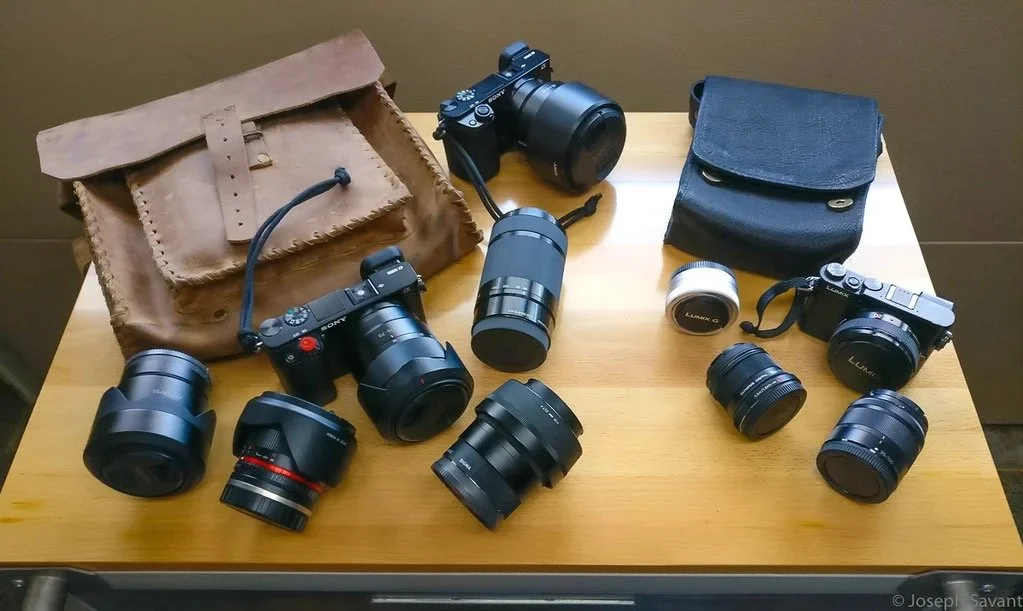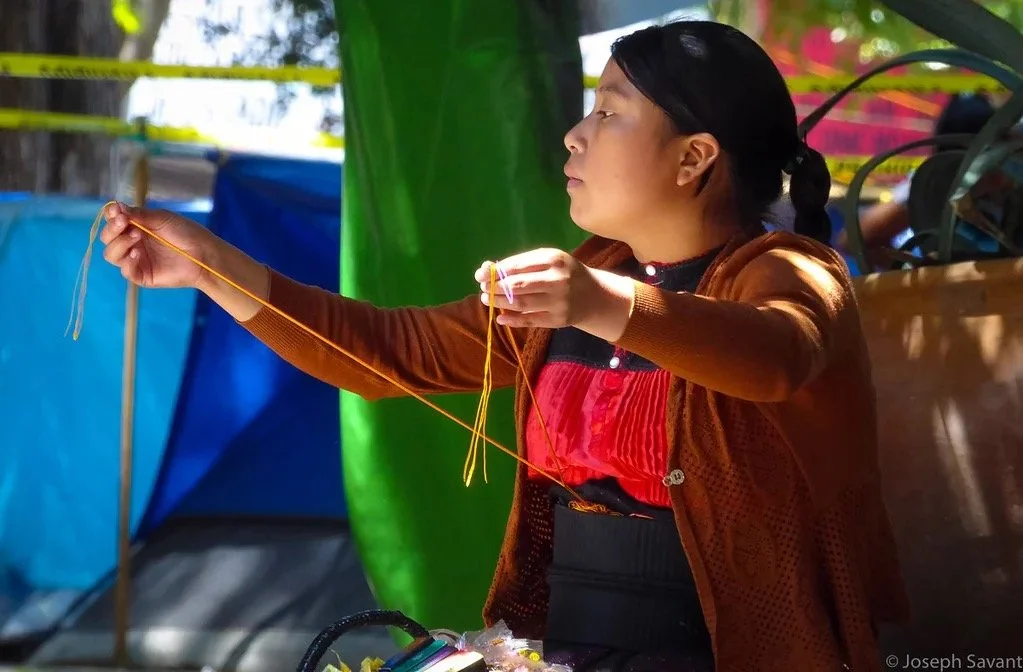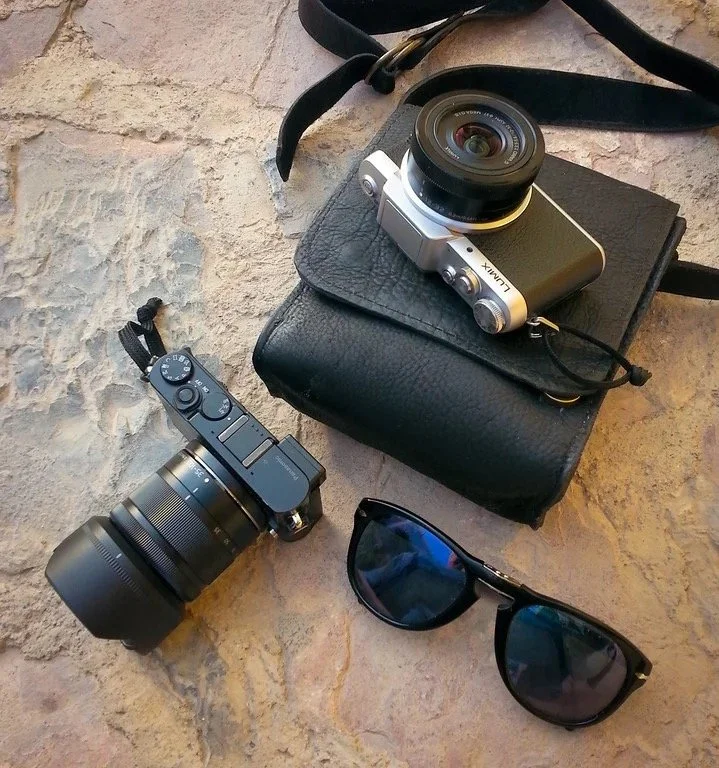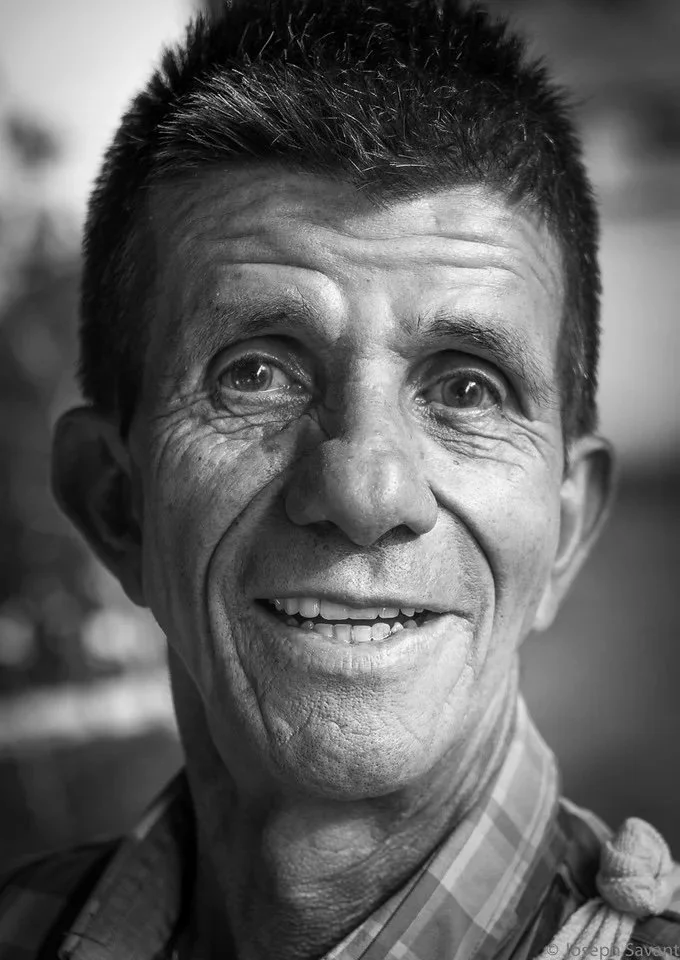12.20.2017
There have been several online requests for advice on camera gear, so the following are some of my thoughts and opinions, biased heavily towards adventure travel by motorcycle.
My background was in advertising and commercial photography, where pre-digital film format sizes from large 8 x 10 cameras to small 35mm were employed. Equipment choices were based on the project, choosing the right tool for the specific job. The same applies in the digital world.
Current Sony A6000 travel kit on the left and the excellent tiny Lumix GM5 kit I took on the previous Alaska leg of this adventure
Sometime, somewhere, I said photography is that rare blend of technology and art, where each depend on the other to produce. Maybe you're a technician where pure color accuracy and image size are critical but there's no creativity required, or maybe you're creative as hell but have no technology genes and get the rare perfect technical image by accident. Two extremes we all fall between.
So, you love photography and want to improve your images? Most folks think the answer is in buying a big pro DSLR and large lenses. If the pros use the camera, it has to eliminate the possibility of poor camera performance, right? That's true to an extent, but buying a big, heavy, expensive system won't automatically make your photographs any better. It will offer higher resolution, and possibly sharper images, with the tradeoff of larger file sizes for storage. If your photos are average and uninteresting, they aren't going to improve with more expensive equipment. Most cameras take excellent images now and the differences are minor.
Since we're looking at gear related to travel, and specifically by motorcycle, you have three or four directions to consider. First, using just a phone will be the smallest, lightest, simplest possible way, however the limitations are in lens selection. But, it offers an option for minimalist travel and may work for your needs. A second choice would be a high quality "prosumer" pocket camera. The image quality is very good, it fits in your pocket or tank bag easily, so it's handy when you need it. The limitations with pocket cameras are typically a limited zoom range, but overall they make a good solution. The third alternative, and the one I'm using on this trip, is a small mirrorless body and interchangeable lenses. The mirrorless design is smaller than a typical DSLR, but rivals it in image quality, especially with excellent lenses. For me, it makes the best system for great image quality in a much smaller footprint. Lastly, is the DSLR system. Until recently, these have been the standard for mobile professional grade images, with many excellent choices available. The downside for travel is the size of the bodies, and worse, the lenses that accompany them. For a weekend motorcycle ride, one might get away with stuffing a system on the bike, however for longer term travels where much more travel gear is needed, spare parts, etc., the DSLR system becomes much harder to pack.
As to the megapixel issue, people think more is better but unless you're an ad shooter, or selling prints in a Jackson, Wyoming gallery, you'll likely never make a wall size print. The megapixel race began years ago to deal with the nightmare of "moiré" patterns on fabrics for studio photographers, where the sensor grids and fabric weave grids would interact creating a weird pattern which was a nightmare to retouch. The magic number for sensors was about 36 mp to reduce or eliminate it.
I'd suggest you set aside the need for megapixels and concentrate on sensor performance, especially for low light. Realistically, 12-16 mp works great and anything above that is gravy, as long as file storage isn't an issue, which on a long term trip can be. Years ago I shot national advertising and collateral campaigns with just a 6 mp camera which was state of the art at the time. Point is, a 16 mp camera will produce beautiful images as much as a 36 mp one. Don’t feel the need to chase very large sensor sizes. Instead focus on color and low light performance which are far more important overall.
The most obvious travel solution is a pocket camera that's durable, easily carried, and small enough to carry as a spare in case of failure. Electronics fail, internal battery chargers stop working, USB ports on the camera fail, etc. If you desire to do street shooting, pocket cams draw less attention and people assume you're just a tourist and ignore you. It's also there when you need it. Many pocket cams take great images - most cameras on the market today do - but you will run into limitations of the genre very quickly. JPG's are often lacking, too contrasty, flat, certain colors false, etc. Lenses in compacts typically aren't sharp and have slow apertures to compensate, at the expense of being terrible in low light. To use them will kick in high ISO and image noise from the small sensors, slow and poor autofocus, with slow shutter speeds that result in camera blur. In bright daylight they will typically work very well.
Having said that, there are some superior compacts that are well above the norm in performance such as the Sony RX series and others. They'll cost you a grand for that performance, but if you want to have a minimal system, they're excellent choices. However, the zoom range is typically limited to the 35mm equivalent range of 24/28 mm to 80/100 mm. Great for most things needed, but you'll be frustrated eventually because you'll want to get better portraits or distant shots.
The other problem small sensor cameras have, aside from noise, is extreme depth of field. In one way it's great as most of the image will be sharp, eliminating some lost shots due to bad focus, but the flip side is that most of the subjects in the image will have equal sharpness and importance, other than compositionally. Some semi-pro pocket cameras have fairly wide apertures and if you choose one, try to get the widest aperture you can, all things being equal. If you want a subject to pop from the background, you'll have to shoot at the longest lens range and widest aperture.
For street shooting, startup time is important. Go for a camera that starts quickly and preferably doesn't have to wait for a lens to extend.
Inherent with capturing travel images is the need for long lenses for people shots from comfortable distances. To give you a sporting chance, you'll need telephoto capabilities. Some superzoom pocket cameras are great for this, as long as you are in sunlight where the aperture limitations aren't evident. In low or failing light, even shade, the lens problems will get you. Superzooms are amazing designs, however physics dictates that wide ranging zooms are usually not sharp. It's always a compromise.
The image below of the girl was taken from a long distance with the Lumix ZS-50 pocket zoom I brought as a backup. It works fairly well in bright conditions for an inexpensive camera, but it is sluggish. Newer versions are better, but will still be limited to bright conditions. I got the shot and it looks good, but there is lack of fine detail compared to the Sony A6000 shots. That's because the sensor is very small and the lens quality can't record the fine details, since the superzoom lens range is a compromise. The fact they can produce a zoom that ranges from 24mm to 300 or so in such a small package that still looks this good is amazing however.
Shot with the Lumix ZS-50 superzoom pocket camera at maximum zoom from a long distance
Those are some of the issues with pocket cameras, and I look forward to the day when technology advances them to a level where they're everything one needs.
In a nutshell when searching for a camera, first decide your budget, then compare startup times, get the lens with the fastest aperture possible, look for a lens range that is 24-28mm at widest and as close to 100mm at the telephoto end, look for the larger sensor size models which will have less noise, and even shoots raw if your'e serious. The pocket cams that have all that will be the more expensive but grab the previous year's model or buy used. If you have no desire to shoot other than in bright daylight, then most pocket cams will do a good job. Most of my older ride reports were shot with the Panasonic LX series, which had limitations but had a good fast lens and made exceptionally images at the time. I liked the little cameras, but the slow startup and limited zoom range and was frustrating.
There are just so many variables and types, I'd suggest looking at DPreview for their silver and gold travel camera recommendations if you want the better models.
From the compact pocket cams, the next step up are the mirrorless designs and quality difference is dramatic. Sensor sizes double and the ability to interchange lenses is huge. The body and lenses are roughly half the size of DSLR's with quality that is really close or in some cases exceeds them. Many non-mirrorless lenses can be adapted as well. Like it or not, mirrorless is the future. If you are serious about travel photography, I wouldn't consider much else for size-to-quality ratio. Not all are created equal, but there are several choices and sizes available. If any issue has risen its head with mirrorless its been lack of fast, critical autofocus in the past and that would be the frustration of it. Sony is getting serious about fast autofocus, and the DSLR is on the road to becoming a dinosaur. I'm not promoting Sony, who have their issues, and Fuji, Olympus and others are producing great images, each with it's own merits and issues.
If you really need a tiny, interchangeable lens system, one of my favorite mini kits - the Lumix GM-5 - is about the size of a deck of cards with a viewfinder. The kit zooms for it are slow but very sharp and there are some outstanding fast primes for it. A little too small for my hands but it has no problem giving excellent images and the primes are great. The images in my trek through North America were done with this camera and it's cheaper cousin, the GF-7 which had a tilt screen. It has some challenges due to size, but it's a brilliant tiny system if you need a really small system.
The tiny Lumix GM-5 and it's cheaper cousin, the GF-7. Hundreds of lens choices and a 16mp Micro 4/3 system.
I am not recommending any particular system, because only you can decide what camera fits your hand, needs, size and budget. Be prepared to try a couple of brands, if not more, before you find a system you like. Buy an almost unused body/lens combo from a doctor/lawyer photo nerd on Craigslist with all the boxes, wrappers and foofoo to try, then flesh out the system or buy a newer body if you like it. If you don't, keep it clean with all the foofoo boxes and resell it.
If you go with an interchangeable lens system and get serious, the lenses are the most important and camera systems should be chosen on that. Optics are the most important aspect of photography, and fast prime lenses are the penultimate, but don't make the mistake of thinking all zooms are crap. They're not. Some zooms are great and if space dictates, two zooms will cover everything you need and give you good or excellent images. Probably 75% of what I shoot is with my Zeiss 16-70 F4 zoom lens. It is brilliantly sharp and though F4 is a bit slow, it still does what I need and lives on one body almost all the time.
With a Sony travel kit, one could do the 10-18 and 18-200 zooms and cover a huge focal range. My previous Fuji travel kit had the 10-24 and 18-135 zooms plus a 56 1.2 prime and produced stellar images. Michnus is using the same system minus the 56. The drawback to zooms are slow apertures, and though good in daylight, they begin to fail as the light drops, requiring slower shutter speeds and the autofocus begins having issues.
Thus to prime lenses... image quality doesn't get any better than a high end, fast aperture, prime lens. Since the elements are fixed as opposed to internal moving elements, they can be exquisitely sharp. Add in a large aperture and you can get razor sharp slices across images that blur backgrounds and force you to look at exactly what you choose.
That said, there are downsides. First and foremost, the razor thin area of focus when wide open likes to live where it chooses and with zero room for error. Zero. Getting what you want in focus can be frustrating and difficult with moving subjects and finicky autofocus. Not a problem in a static portrait but for street work, a challenge. Secondly, in a dynamic situation you are stuck with the lens length. You use the old fashioned zoom called "your feet." Changing lenses on the street doesn't work well and when you drop a lens you'll see why, not to mention the sensor dust you'll get, and whatever you're trying to catch will be gone by the time you get the lens swapped. You'll end up with a second body and wish for a third. That's why the photojournalists always had 4 bodies hanging off them and 30 pound camera bags. Been there, done that.
Shot with Sony A6000 and Sony 85mm f1.8 FE lens
Prime lenses will spoil you for sharpness and shallow depth of field, and if you just can't go back to zooms, get a couple of bodies with a couple of primes on them. A good range would be a 16/18/23 mm on one body for overall shots and a second with your choice of 30/55/85/90mm lens for tighter stuff. That's the basic photojournalist load for street shooting. And now your kit is getting bigger and heavier :D
Despite my gear load on this trip, I basically use two lenses. I keep the 16-70 f4 and 85mm f1.8 on the bodies most of the time, then at night I bag the 16-70 and alternate between the Sigma 30 f1.4 and Zeiss 55 f1.8 lenses. Even with the older A-6000 sensor, I can still shoot in low light with the 16-70 f4 and get good results.
If I survive this trip with any money left, the other system I'm intrigued with is the 1" sensor superzoom cameras by both Sony and Panasonic, the RX10 series and FZ1000/2000 respectively. I've seen some shots with them and have been impressed. The idea of a sealed body, amazing zoom range, and no changing or carrying lenses is appealing. As long as image quality is there I'm up for it. Downside is that the body is as big as a DSLR and more intimidating on the street than smaller bodies, but fast shooting and minimalism would likely compensate. Carrying an extra camera as a backup would still take up less room than the kit I have. Shallow depth of field and low light performance would be my concerns.
Another thing to consider is the carrying case you use on the street. Discretion is the best way to go, but unfortunately manufacturers are more interested in showcasing their logos and produce bags that scream camera. Traveling pros have always known that camouflage is important and used to choose older, nondescript luggage with gear inside. Many times in airports I'd be sitting with an assistant and beat up looking luggage, carrying $50k in gear inside and watching the tourists walking past with huge camera bags. For travel be as wise as you can and unfortunately there are very, very few manufacturers making low key, non-descript bags, so get some lens pouches and carry your gear in something that draws less attention on the street. I had my leather bag made in Guanajuato for $40 and it turned out great for what I need. People assume it's just a leather travel bag.
Since this trip might be a once-in-lifetime deal, I brought more gear than typical, but thought it out well and so far I wouldn't change a thing. It's worked well and I've used all of it. The small pocket zoom I'm carrying has gotten me a couple of good shots and it's good for daylight work. It stays in the tank bag or pocket as a grab shot camera.
Realistically, shoot with whatever makes you happy, as long as you can pack it on the bike and can carry it around all day and night.
Okay, I've bored you enough with some gear opinions, and will post a second update touching the more "artistic" and "realistic" aspects of shooting - learning to see and how to get images on the street... but not today.
#SonyA6000 #StreetPhotography #Motorcycle #Adventure




